automatic transmission FIAT FIORINO 2019 Owner handbook (in English)
[x] Cancel search | Manufacturer: FIAT, Model Year: 2019, Model line: FIORINO, Model: FIAT FIORINO 2019Pages: 220, PDF Size: 6.22 MB
Page 70 of 220
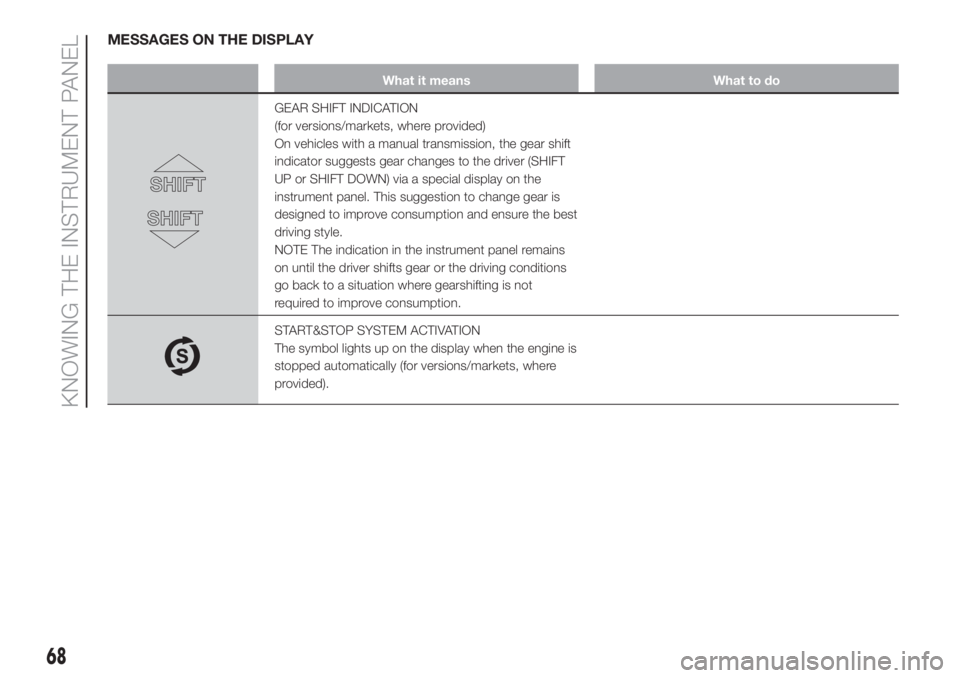
MESSAGES ON THE DISPLAY
What it means What to do
GEAR SHIFT INDICATION
(for versions/markets, where provided)
On vehicles with a manual transmission, the gear shift
indicator suggests gear changes to the driver (SHIFT
UP or SHIFT DOWN) via a special display on the
instrument panel. This suggestion to change gear is
designed to improve consumption and ensure the best
driving style.
NOTE The indication in the instrument panel remains
on until the driver shifts gear or the driving conditions
go back to a situation where gearshifting is not
required to improve consumption.
START&STOP SYSTEM ACTIVATION
The symbol lights up on the display when the engine is
stopped automatically (for versions/markets, where
provided).
68
KNOWING THE INSTRUMENT PANEL
Page 72 of 220
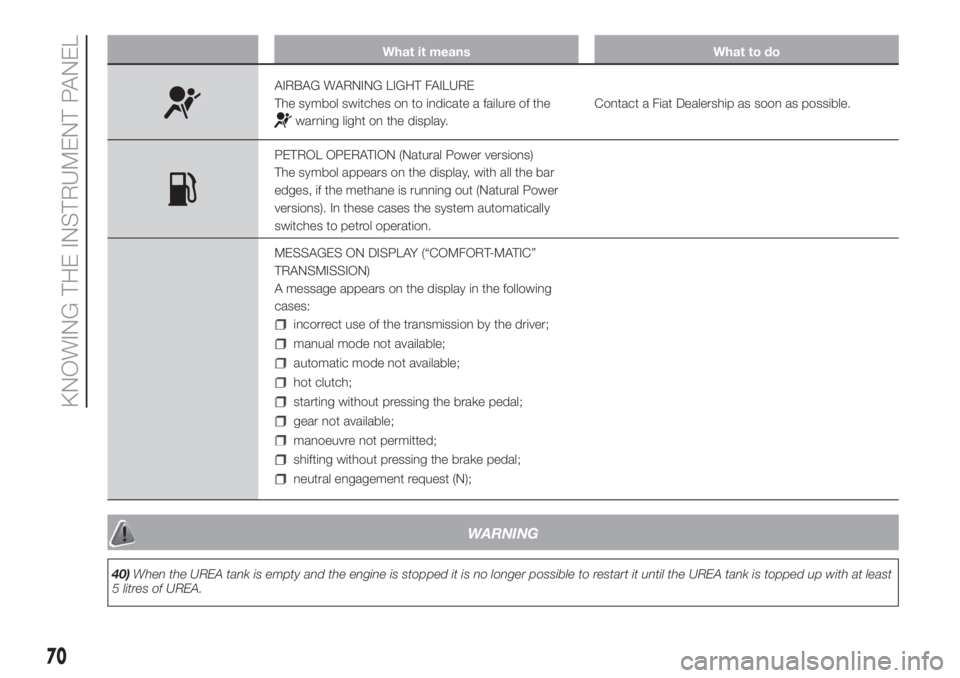
What it means What to do
AIRBAG WARNING LIGHT FAILURE
The symbol switches on to indicate a failure of the
warning light on the display.Contact a Fiat Dealership as soon as possible.
PETROL OPERATION (Natural Power versions)
The symbol appears on the display, with all the bar
edges, if the methane is running out (Natural Power
versions). In these cases the system automatically
switches to petrol operation.
MESSAGES ON DISPLAY (“COMFORT-MATIC”
TRANSMISSION)
A message appears on the display in the following
cases:
incorrect use of the transmission by the driver;
manual mode not available;
automatic mode not available;
hot clutch;
starting without pressing the brake pedal;
gear not available;
manoeuvre not permitted;
shifting without pressing the brake pedal;
neutral engagement request (N);
WARNING
40)When the UREA tank is empty and the engine is stopped it is no longer possible to restart it until the UREA tank is topped up with at least
5 litres of UREA.
70
KNOWING THE INSTRUMENT PANEL
Page 101 of 220
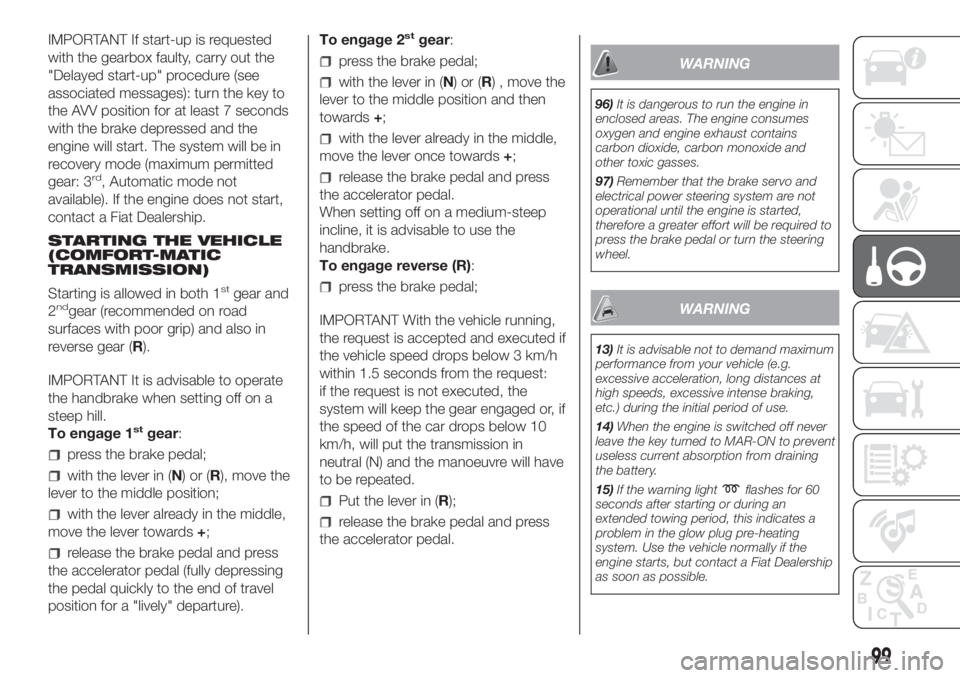
IMPORTANT If start-up is requested
with the gearbox faulty, carry out the
"Delayed start-up" procedure (see
associated messages): turn the key to
the AVV position for at least 7 seconds
with the brake depressed and the
engine will start. The system will be in
recovery mode (maximum permitted
gear: 3
rd, Automatic mode not
available). If the engine does not start,
contact a Fiat Dealership.
STARTING THE VEHICLE
(COMFORT-MATIC
TRANSMISSION)
Starting is allowed in both 1
stgear and
2ndgear (recommended on road
surfaces with poor grip) and also in
reverse gear (R).
IMPORTANT It is advisable to operate
the handbrake when setting off on a
steep hill.
To engage 1
stgear:
press the brake pedal;
with the lever in (N)or(R), move the
lever to the middle position;
with the lever already in the middle,
move the lever towards+;
release the brake pedal and press
the accelerator pedal (fully depressing
the pedal quickly to the end of travel
position for a "lively" departure).To engage 2
stgear:
press the brake pedal;
with the lever in (N)or(R) , move the
lever to the middle position and then
towards+;
with the lever already in the middle,
move the lever once towards+;
release the brake pedal and press
the accelerator pedal.
When setting off on a medium-steep
incline, it is advisable to use the
handbrake.
To engage reverse (R):
press the brake pedal;
IMPORTANT With the vehicle running,
the request is accepted and executed if
the vehicle speed drops below 3 km/h
within 1.5 seconds from the request:
if the request is not executed, the
system will keep the gear engaged or, if
the speed of the car drops below 10
km/h, will put the transmission in
neutral (N) and the manoeuvre will have
to be repeated.
Put the lever in (R);
release the brake pedal and press
the accelerator pedal.
WARNING
96)It is dangerous to run the engine in
enclosed areas. The engine consumes
oxygen and engine exhaust contains
carbon dioxide, carbon monoxide and
other toxic gasses.
97)Remember that the brake servo and
electrical power steering system are not
operational until the engine is started,
therefore a greater effort will be required to
press the brake pedal or turn the steering
wheel.
WARNING
13)It is advisable not to demand maximum
performance from your vehicle (e.g.
excessive acceleration, long distances at
high speeds, excessive intense braking,
etc.) during the initial period of use.
14)When the engine is switched off never
leave the key turned to MAR-ON to prevent
useless current absorption from draining
the battery.
15)If the warning light
flashes for 60
seconds after starting or during an
extended towing period, this indicates a
problem in the glow plug preheating
system. Use the vehicle normally if the
engine starts, but contact a Fiat Dealership
as soon as possible.
99
Page 103 of 220

PARKING THE
VEHICLE
101)
Proceed as follows when parking and
leaving the vehicle:
engage a gear (1stgear if facing
uphill or reverse if facing downhill) and
leave the wheels turned;
stop the engine and engage the
handbrake;
always remove the ignition key.
If the vehicle is parked on a steep
slope, it is advisable to block the
wheels with a wedge or stone.
Do not leave the key in the MAR
position to prevent the battery from
running down.
Versions with COMFORT-MATIC
transmission
To park safely, keeping a foot on the
brake pedal, the 1
stor reverse (R) gear
must be engaged and, in case of
parking uphills/downhills, the
handbrake must be engaged.
IMPORTANT NEVER leave the vehicle
with the transmission in neutral (N)
or, on versions equipped with automatic
(Comfort matic) transmission, before
putting the shift lever in thePposition.IMPORTANT NOTES
With the vehicle stationary and a
gear engaged, always keep the brake
pedal pressed until you decide to
set off, then release the brake and
accelerate gently;
during prolonged stops with the
engine running, it is advisable to keep
the gearbox in neutral (N);
In order to safeguard the efficiency
of the clutch, do not use the
accelerator to keep the vehicle
stationary (e.g. when stopped on an
incline);
the clutch could overheat and be
damaged; use the brake pedal and only
operate the accelerator pedal when
you decide to set off;
only use second gear when you
need greater control for starting
manoeuvres on surfaces with poor grip;
if, with reverse gear (R) engaged,
you have to engage first gear or vice
versa, only do this when the vehicle is
completely stationary and with the
brake pedal pressed;
although it is strongly inadvisable, if
you are driving downhill and, for
unexpected reasons, you let the vehicle
move forward with the transmission in
neutral (N), when you engage a gear,
the system will automatically engage
the best gear to transmit the correct
drive torque to the wheels depending
on the vehicle's speed;
WARNING
101)Never leave children unattended in
the vehicle. Always remove the ignition key
when leaving the vehicle and take it out
with you.
101
Page 105 of 220
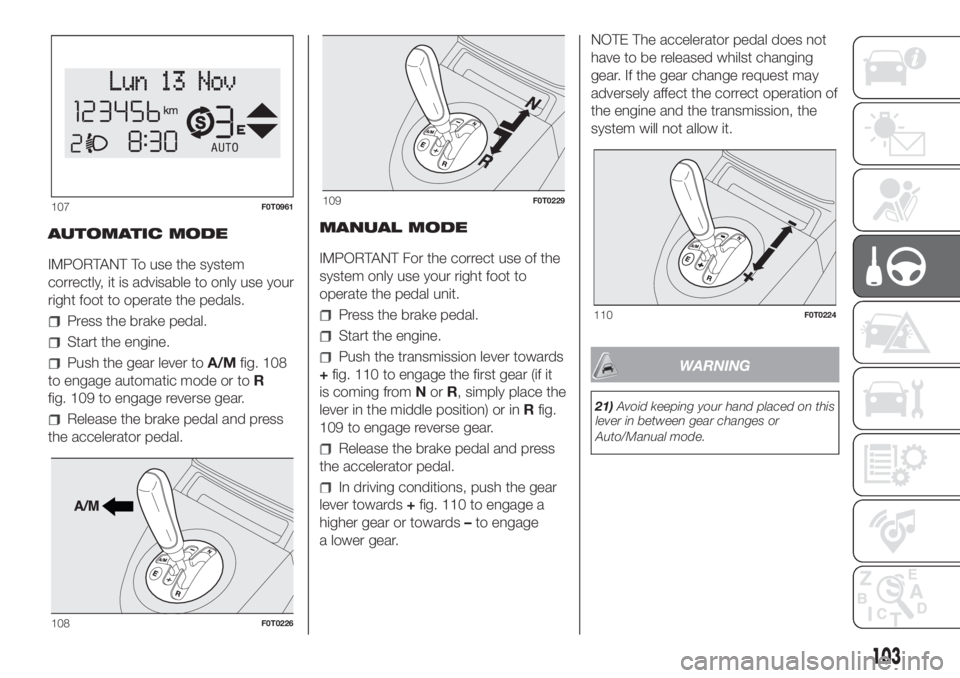
AUTOMATIC MODE
IMPORTANT To use the system
correctly, it is advisable to only use your
right foot to operate the pedals.
Press the brake pedal.
Start the engine.
Push the gear lever toA/Mfig. 108
to engage automatic mode or toR
fig. 109 to engage reverse gear.
Release the brake pedal and press
the accelerator pedal.MANUAL MODE
IMPORTANT For the correct use of the
system only use your right foot to
operate the pedal unit.
Press the brake pedal.
Start the engine.
Push the transmission lever towards
+fig. 110 to engage the first gear (if it
is coming fromNorR, simply place the
lever in the middle position) or inRfig.
109 to engage reverse gear.
Release the brake pedal and press
the accelerator pedal.
In driving conditions, push the gear
lever towards+fig. 110 to engage a
higher gear or towards–to engage
a lower gear.NOTE The accelerator pedal does not
have to be released whilst changing
gear. If the gear change request may
adversely affect the correct operation of
the engine and the transmission, the
system will not allow it.
WARNING
21)Avoid keeping your hand placed on this
lever in between gear changes or
Auto/Manual mode.
107F0T0961
108F0T0226
109F0T0229
110F0T0224
103
Page 107 of 220

Deactivating the function
The device can be switched off by the
driver in the following ways:
by pressing the brake pedal when
the device is adjusting the speed:
by pressing the clutch pedal when
the device is adjusting the speed;
by pressing button B fig. 111 when
the device is adjusting the speed (for
versions/markets, where provided);
by pressing the accelerator pedal (in
this case the system is not actually
turned off but the acceleration request
takes priority; the cruise control remains
activated, without the need to the
press button B fig. 111 to restore the
previous conditions once the
acceleration is over).
The device is automatically switched off
in the following cases:
if the ABS or ESC systems
intervene;
with the vehicle speed below the set
limit
in the event of system failure.
103) 104)
WARNING
103)When travelling with the device active,
never move the gear lever to neutral.
104)In the event of device faults or failures,
turn knob A to OFF and contact a Fiat
Dealership.
SPEED BLOCK
(for 1.3 MultiJet versions with manual
transmission)
The vehicle is equipped with a speed
limitation function that can be set on
the user's request to one of four default
values. 90, 100, 110, 130 km/h.
To activate/deactivate this function,
contact a Fiat Dealership.
Following the operation, a sticker fig.
112 will be applied to the windscreen
showing the top speed setting.
IMPORTANT The speedometer could
indicate a higher maximum speed than
the effective one, set by the Dealership,
in accordance with the regulations in
force.
112F0T0330
105
Page 110 of 220
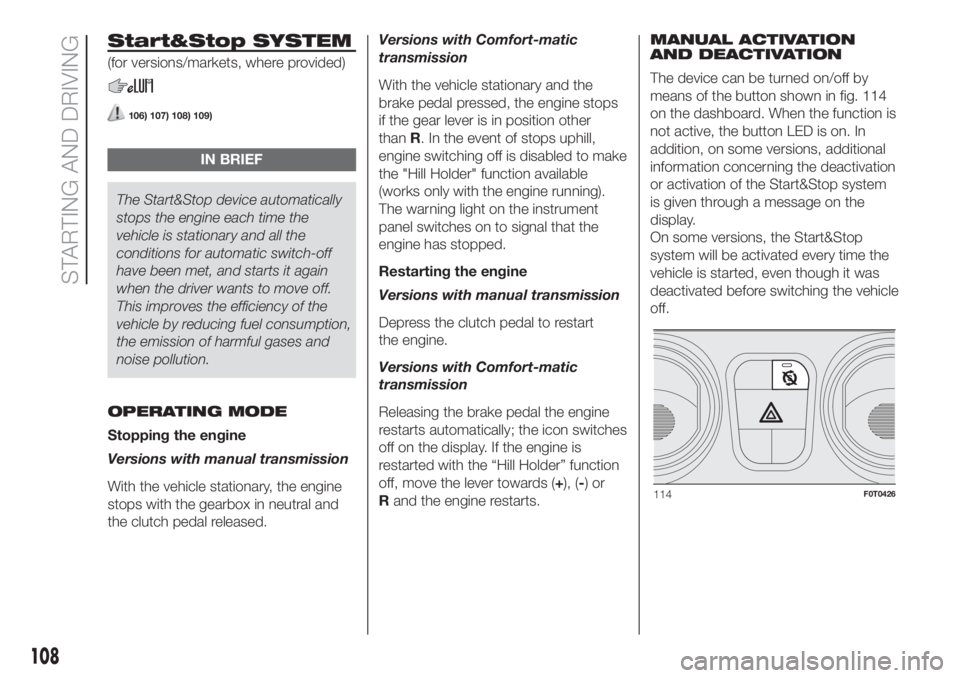
Start&Stop SYSTEM
(for versions/markets, where provided)
106) 107) 108) 109)
IN BRIEF
The Start&Stop device automatically
stops the engine each time the
vehicle is stationary and all the
conditions for automatic switch-off
have been met, and starts it again
when the driver wants to move off.
This improves the efficiency of the
vehicle by reducing fuel consumption,
the emission of harmful gases and
noise pollution.
OPERATING MODE
Stopping the engine
Versions with manual transmission
With the vehicle stationary, the engine
stops with the gearbox in neutral and
the clutch pedal released.Versions with Comfort-matic
transmission
With the vehicle stationary and the
brake pedal pressed, the engine stops
if the gear lever is in position other
thanR. In the event of stops uphill,
engine switching off is disabled to make
the "Hill Holder" function available
(works only with the engine running).
The warning light on the instrument
panel switches on to signal that the
engine has stopped.
Restarting the engine
Versions with manual transmission
Depress the clutch pedal to restart
the engine.
Versions with Comfort-matic
transmission
Releasing the brake pedal the engine
restarts automatically; the icon switches
off on the display. If the engine is
restarted with the “Hill Holder” function
off, move the lever towards (+), (-)or
Rand the engine restarts.MANUAL ACTIVATION
AND DEACTIVATION
The device can be turned on/off by
means of the button shown in fig. 114
on the dashboard. When the function is
not active, the button LED is on. In
addition, on some versions, additional
information concerning the deactivation
or activation of the Start&Stop system
is given through a message on the
display.
On some versions, the Start&Stop
system will be activated every time the
vehicle is started, even though it was
deactivated before switching the vehicle
off.
114F0T0426
108
STARTING AND DRIVING
Page 143 of 220
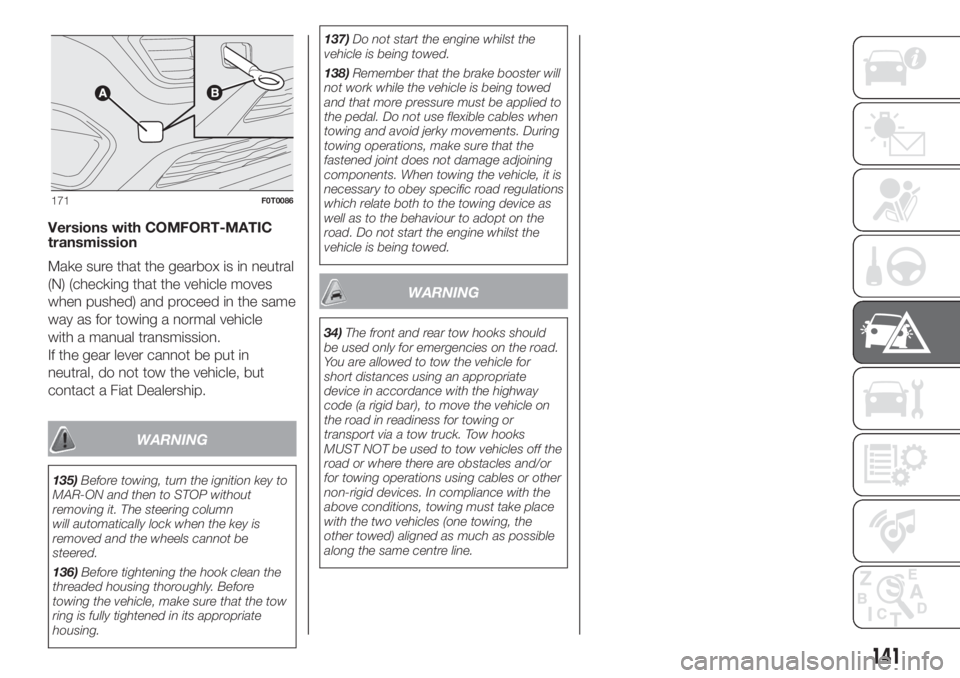
Versions with COMFORT-MATIC
transmission
Make sure that the gearbox is in neutral
(N) (checking that the vehicle moves
when pushed) and proceed in the same
way as for towing a normal vehicle
with a manual transmission.
If the gear lever cannot be put in
neutral, do not tow the vehicle, but
contact a Fiat Dealership.
WARNING
135)Before towing, turn the ignition key to
MAR-ON and then to STOP without
removing it. The steering column
will automatically lock when the key is
removed and the wheels cannot be
steered.
136)Before tightening the hook clean the
threaded housing thoroughly. Before
towing the vehicle, make sure that the tow
ring is fully tightened in its appropriate
housing.137)Do not start the engine whilst the
vehicle is being towed.
138)Remember that the brake booster will
not work while the vehicle is being towed
and that more pressure must be applied to
the pedal. Do not use flexible cables when
towing and avoid jerky movements. During
towing operations, make sure that the
fastened joint does not damage adjoining
components. When towing the vehicle, it is
necessary to obey specific road regulations
which relate both to the towing device as
well as to the behaviour to adopt on the
road. Do not start the engine whilst the
vehicle is being towed.
WARNING
34)The front and rear tow hooks should
be used only for emergencies on the road.
You are allowed to tow the vehicle for
short distances using an appropriate
device in accordance with the highway
code (a rigid bar), to move the vehicle on
the road in readiness for towing or
transport via a tow truck. Tow hooks
MUST NOT be used to tow vehicles off the
road or where there are obstacles and/or
for towing operations using cables or other
non-rigid devices. In compliance with the
above conditions, towing must take place
with the two vehicles (one towing, the
other towed) aligned as much as possible
along the same centre line.
171F0T0086
141
Page 185 of 220

Use Features SpecificationOriginal fluids and
lubricantsApplications /
Replacement
frequency
Lubricants and greases
for drive transmissionSAE 75W- 85 grade
synthetic lubricant.9.55550-MX3TUTELA
TRANSMISSION
TECHNYX
Contractual Technical
Reference N° F010.B05Mechanical differentials
and gearboxes (Diesel and
1.4 Euro 6 versions)
Specific fluid for electro-
hydraulic ratio selector
actuators.9.55550-SA1TUTELA CAR CS
SPEED
Contractual Technical
Reference No. F005.F98COMFORT-MATIC
electrically controlled
electrohydraulic actuator
Molybdenum disulphide
grease, for use at high
temperatures. N.L.G.I.
consistency 1-2.9.55580-GRAS IITUTELA ALL STAR
Contractual Technical
Reference N° F702.G07Wheel side constant
velocity joints
Grease for constant
velocity joints with low
friction coefficient. N.L.G.I.
consistency 0-1.9.55580-GRAS IITUTELA STAR 700
Contractual Technical
Reference N° F701.C07Differential side constant
velocity joints
Automatic transmission
lubricant. Exceeding ATF
DEXRON III specifications.9.55550- AG2TUTELA
TRANSMISSION GI/E
Contractual Technical
Reference N° F001.C94Hydraulic power steering
Brake fluidSynthetic fluid, NHTSA no.
116 DOT 4, ISO 4925,
SAE J-1704, CUNA NC
956-01.9.55597orMS.90039TUTELA TOP 4
Contractual Technical
Reference N° F001.A93
or
TUTELA TOP 4/S
Contractual Technical
Reference N° F005.F15Hydraulic brakes and
hydraulic clutch controls
183
Page 201 of 220
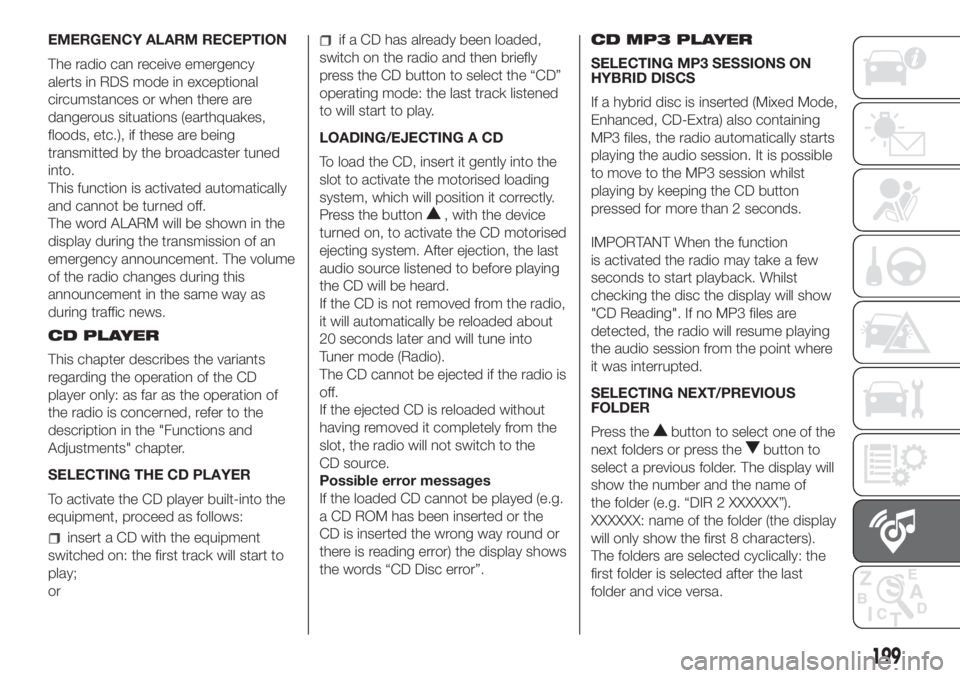
EMERGENCY ALARM RECEPTION
The radio can receive emergency
alerts in RDS mode in exceptional
circumstances or when there are
dangerous situations (earthquakes,
floods, etc.), if these are being
transmitted by the broadcaster tuned
into.
This function is activated automatically
and cannot be turned off.
The word ALARM will be shown in the
display during the transmission of an
emergency announcement. The volume
of the radio changes during this
announcement in the same way as
during traffic news.
CD PLAYER
This chapter describes the variants
regarding the operation of the CD
player only: as far as the operation of
the radio is concerned, refer to the
description in the "Functions and
Adjustments" chapter.
SELECTING THE CD PLAYER
To activate the CD player built-into the
equipment, proceed as follows:
insert a CD with the equipment
switched on: the first track will start to
play;
or
if a CD has already been loaded,
switch on the radio and then briefly
press the CD button to select the “CD”
operating mode: the last track listened
to will start to play.
LOADING/EJECTING A CD
To load the CD, insert it gently into the
slot to activate the motorised loading
system, which will position it correctly.
Press the button
, with the device
turned on, to activate the CD motorised
ejecting system. After ejection, the last
audio source listened to before playing
the CD will be heard.
If the CD is not removed from the radio,
it will automatically be reloaded about
20 seconds later and will tune into
Tuner mode (Radio).
The CD cannot be ejected if the radio is
off.
If the ejected CD is reloaded without
having removed it completely from the
slot, the radio will not switch to the
CD source.
Possible error messages
If the loaded CD cannot be played (e.g.
a CD ROM has been inserted or the
CD is inserted the wrong way round or
there is reading error) the display shows
the words “CD Disc error”.CD MP3 PLAYER
SELECTING MP3 SESSIONS ON
HYBRID DISCS
If a hybrid disc is inserted (Mixed Mode,
Enhanced, CD-Extra) also containing
MP3 files, the radio automatically starts
playing the audio session. It is possible
to move to the MP3 session whilst
playing by keeping the CD button
pressed for more than 2 seconds.
IMPORTANT When the function
is activated the radio may take a few
seconds to start playback. Whilst
checking the disc the display will show
"CD Reading". If no MP3 files are
detected, the radio will resume playing
the audio session from the point where
it was interrupted.
SELECTING NEXT/PREVIOUS
FOLDER
Press the
button to select one of the
next folders or press the
button to
select a previous folder. The display will
show the number and the name of
the folder (e.g. “DIR 2 XXXXXX”).
XXXXXX: name of the folder (the display
will only show the first 8 characters).
The folders are selected cyclically: the
first folder is selected after the last
folder and vice versa.
199